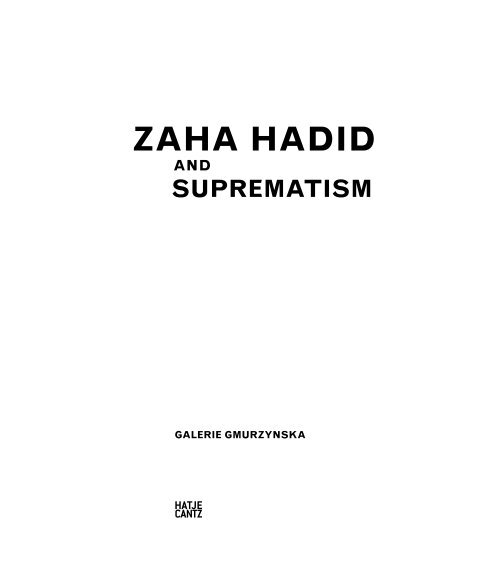Patrik Schumacher – The Russian Avant Garde – A Glimpse Back into the Future
Excerpt from the book “Zaha Hadid and Suprematism”, published by Galerie Gmurzynska in collaboration with Hatje Cantz on the occasion of an exhibition at the gallery space in Zurich, designed by Zaha Hadid and Patrik Schumacher.
Excerpt from the book “Zaha Hadid and Suprematism”, published by Galerie Gmurzynska in collaboration with Hatje Cantz on the occasion of an exhibition at the gallery space in Zurich, designed by Zaha Hadid and Patrik Schumacher.
Create successful ePaper yourself
Turn your PDF publications into a flip-book with our unique Google optimized e-Paper software.
ZAHA HADID<br />
AND<br />
SUPREMATISM<br />
GALERIE GMURZYNSKA
<strong>Patrik</strong> <strong>Schumacher</strong><br />
The <strong>Russian</strong> <strong>Avant</strong> <strong>Garde</strong> —<br />
A <strong>Glimpse</strong> <strong>Back</strong> <strong>into</strong> <strong>the</strong> <strong>Future</strong><br />
23<br />
Over ninety years ago <strong>the</strong> October Revolution ignited <strong>the</strong> most exuberant<br />
surge of creative energy that has ever erupted on planet earth. While some<br />
of <strong>the</strong> artistic seeds were present beforehand, <strong>the</strong>y blossomed and<br />
proliferated thousand-fold in <strong>the</strong> first ten years of <strong>the</strong> revolution. This<br />
amazing firework of creative exuberance took off under <strong>the</strong> most severe<br />
material circumstances—fueled by <strong>the</strong> idealistic enthusiasm for <strong>the</strong><br />
project of a new society. The pace, quantity, and quality of <strong>the</strong> creative<br />
work in art, science, and design was truly astounding, anticipating in one<br />
intense flash what <strong>the</strong>n took ano<strong>the</strong>r fifty years to unfold elsewhere in <strong>the</strong><br />
world. In art and design <strong>the</strong>re is nothing of note during <strong>the</strong> twentieth<br />
century that was not already experimented with during <strong>the</strong> first decade of<br />
<strong>the</strong> October Revolution—only at <strong>the</strong> end of <strong>the</strong> century did <strong>the</strong> microelectronic<br />
revolution open up a whole new universe of possibilities that<br />
could not have been dreamed of at <strong>the</strong> beginning of <strong>the</strong> century.
24<br />
The 1920s avant garde not only anticipated <strong>the</strong> urbanist concept of <strong>the</strong><br />
1950s, but projects were designed that anticipated <strong>the</strong> mega-structure<br />
utopias of <strong>the</strong> mid 1960s and <strong>the</strong> high-tech style of <strong>the</strong> 1970s. Ivan<br />
Leonidov’s 1927 project for <strong>the</strong> Lenin Institute was fifty years ahead of its<br />
time and his 1934 competition entry for <strong>the</strong> Soviet Ministry of Industry—a<br />
composition of different towers placed upon an urban podium—remains an<br />
inspiration for metropolitan architecture today. What is most refreshing<br />
about <strong>the</strong>se projects is <strong>the</strong> way in which <strong>the</strong>y were embedded within an<br />
intense discourse promoted by exhibitions, academic institutions, and<br />
public competitions.<br />
These projects—in all <strong>the</strong>ir experimental radicality—had a real social<br />
meaning and political substance. But <strong>the</strong>ir originality and artistic ingenuity<br />
transcends <strong>the</strong> context of <strong>the</strong> grand <strong>Russian</strong> social experiment. For<br />
instance, Alexander Rodchenko’s amazing hanging sculptures are pure<br />
explorations of space, which opened up a whole new sensibility—<strong>the</strong><br />
sensibility of <strong>the</strong> space age—and, grouped as a constellation, produce one<br />
of <strong>the</strong> most sublime art experiences of all time.<br />
It is a well-established fact that <strong>the</strong> work of Zaha Hadid took its first<br />
inspiration from <strong>the</strong> early <strong>Russian</strong> avant garde, in particular from <strong>the</strong> work<br />
of Kazimir Malevich. Malevich stands here for <strong>the</strong> enormously momentous<br />
discovery of abstraction as a heuristic principle that can propel creative<br />
work to hi<strong>the</strong>rto unheard of levels of invention. Mimesis was finally<br />
abandoned and unfettered creativity could pour out across <strong>the</strong> infinitely<br />
receptive blank canvas. Space, or even better <strong>the</strong> world itself, soon<br />
became <strong>the</strong> site of pure, unprejudiced invention. Malevich has been a<br />
pioneer of abstraction and a pioneer in directly linking abstract art with<br />
architecture via his seminal Tektoniks. It is interesting however, to<br />
observe that <strong>the</strong>se Tektonik sculptures, which were conceived of as a kind<br />
of proto-architecture, were geometrically far more constrained than his<br />
compositions on canvas. The Tektoniks are dynamic equilibrium<br />
compositions that strictly adhere to <strong>the</strong> principle of orthogonality and are
composed by cubic volumes with adjoining surfaces, thus excluding<br />
interpenetration. These “Cubist” restrictions characterized most of <strong>the</strong><br />
modern architectural work in Russia and elsewhere. Zaha Hadid’s work<br />
quickly disposed of <strong>the</strong>se seemingly inviolate architectural principles and<br />
translated <strong>the</strong> warped and anti-gravitational space of <strong>Russian</strong> avant-garde<br />
painting and sculpture <strong>into</strong> her own unique architectural language. The<br />
inspiration came from <strong>the</strong> paintings of Malevich and László Moholy-Nagy,<br />
El Lissitzky’s Prouns, and Naum Gabo’s sculptures.<br />
25
















